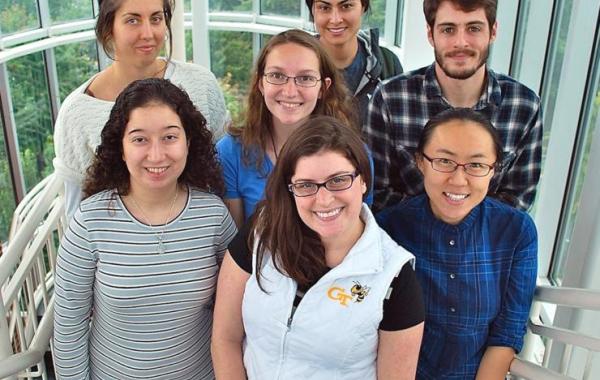The Chemistry of Microbes

Glass lab
Microbes are living proof of strength in numbers. Too small to be seen with the naked eye, they nonetheless comprise most of the Earth’s biomass, exerting their influence on every aspect of the environment. Understand microbes and you’ve unlocked the door to understanding the past and future of our species and our planet.
“If you think back over history, over geologic time, microorganisms have driven the chemistry of the Earth,” says Jennifer Glass, assistant professor in the School of Earth and Atmospheric Sciences and faculty member of the Petit Institute for Bioengineering and Bioscience. “So our lab tends to be microbe centered.”
Her lab specializes in biogeochemistry, which is, “kind of a medley of disciplines,” says Glass, a program faculty member within the newly established Ph.D. in Quantitative Biosciences (QBioS) at the Georgia Institute of Technology.
More than 50 faculty members from a wide range of disciplines came together last fall to launch QBioS. The program's mission is to train Ph.D. level scientists, enabling the discovery of scientific principles underlying the dynamics, structure, and function of living systems.
“This combination is what is needed from the next generation of scientists if we are to understand principles of living systems and, in turn, tackle global-scale challenges,” says QBioS Director Joshua Weitz, associate professor in the School of Biology, courtesy associate professor in the School of Physics, and a member of the Petit Institute for Bioengineering and Bioscience.
Students will pursue thesis research across a broad range of themes, including ecology and earth systems, which is Glass’s area.
Glass and her lab members are particularly interested in researching microbes that produce or consume greenhouse gases (like methane and nitrous oxide, both many times more potent than carbon dioxide). For example, they’d really like to understand how ocean systems do such a good job of both making and quelling the methane that comes from the depths.
“A lot of methane is produced in the sediments of the ocean, yet not very much makes it to the atmosphere – it’s only three percent of global sources,” says Glass, whose research currently draws funding from NASA Exobiology, the NASA Astrobiology Institute Alternative Earths team, and NSF Biological Oceanography. “So the ocean is very good at trapping most of the methane that is produced in the sediments.”
So, on the one hand they’re trying to understand exactly where that potential source of natural gas is coming from, and on the other, they want to understand how to leverage natural processes to scrub out harmful emissions. And this is a team that will routinely go to the source to find its samples.
“We try to make our work environmentally relevant, so we go out and sample marine systems or lakes or lake sediments, trying to get representative samples so that what we’re working on in the lab closely represents what’s in the environment,” says Glass. “You have to go to these exotic environments to discover novel ways that nature makes and then consumes greenhouse gases.”
Getting out of the lab into world comes naturally to Glass, who grew up in an outdoorsy family in Olympia, Washington.
She spent her youth hiking and exploring, romping through marshes with her family, developing an interest in environmental issues that has evolved into full-blown expertise in the clandestine chemistry of microbes and a better grasp of their affect on the Earth’s health.
“We don’t know yet what the applications of the research will be,” says Glass. “But I think the sky will be the limit.”
LINKS:
CONTACT:
Jerry Grillo
Communications Officer II
Parker H. Petit Institute for
Bioengineering and Bioscience
